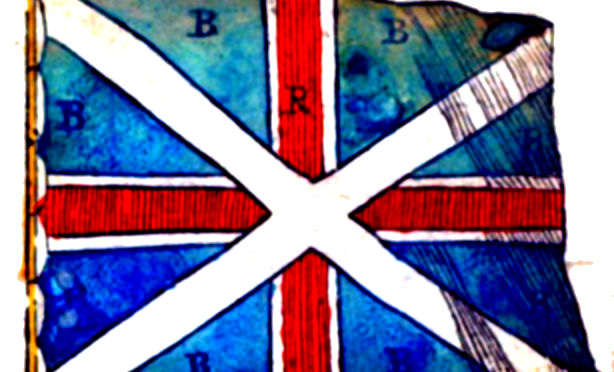The Jointure or the Golden Star is an interesting old Irish harp tune. In this blog post we will look at Edward Bunting’s earliest notations of the melody and the jig that goes with it.
Continue reading The Jointure, or the Golden StarTag: Connellan
Molly George
The next couple of pages of Bunting’s transcription notebook (Queen’s University Belfast, Special Collections, MS4.29 p.158-60) are tunes from Denis O’Hampsey, and so I skipped over those to get to MS4.29 page 161 which has a tune titled “Molly George”.
Continue reading Molly GeorgeLament for the Union
I have long been interested in the organisation of society, the use of symbols and ideas to motivate people and populations, and the structures and institutions that express and control the aspirations and ideas of peoples. Many years ago I got hold of a copy of Uniting the Kingdom (ed. Grant & Stringer, 1995), a book of historical essays on the relations between Scotland and England from earliest times through to the present day. From that point of view the current Union is a curious and unusual settlement.
I find it very interesting to be here at the time of the referendum, when people are talking passionately on all sides about the way that the nation and the state and society are set up, administered and controlled.
 I have for some years been aware of the pibroch titled “Lament for the Union”. Now that I have finally got it up and running as a harp tune, I love it! The ground is a plaintive, emotional lament, full of regret and pathos. The variations by contrast are very different, with unexpectedly changing rythym from 4-time to 3-time and back to 4 time, and with a brooding, urgent, almost menacing sequence of theme notes, and a progression of gestures which becomes quite frantic, like the excited chattering of political activists.
I have for some years been aware of the pibroch titled “Lament for the Union”. Now that I have finally got it up and running as a harp tune, I love it! The ground is a plaintive, emotional lament, full of regret and pathos. The variations by contrast are very different, with unexpectedly changing rythym from 4-time to 3-time and back to 4 time, and with a brooding, urgent, almost menacing sequence of theme notes, and a progression of gestures which becomes quite frantic, like the excited chattering of political activists.
I have put together a programme of a few other tunes with direct connection to the political events of three hundred years ago, when Scotland and England stopped being independent nations and joined together as a united kingdom. I will be playing this new programme for the first time at a referendum-themed art exhibition in Cupar this coming Saturday. I don’t know how many people we will get turning up at 11.30am on a Saturday morning but either way it will be a good opportunity for me to shake down this new programme!
‘Hear the Nation’
Saturday 21st June 2014 , 10.00 am – 4.00 pm
featuring contributions from
‘Yes’, ‘No’ and ‘Undecided’ writers, artists, and musicians
Botanic Baroque
On Saturday evening I will be at the botanic gardens here in St Andrews for an outside evening concert. I’ll have my 18th century Irish harp with me and will be playing a programme of “Carolan, Connellan & Lyons”.
The Downhill harp is loud and strident enough to work in an outdoors setting, and I am hoping that the elegant and sweet tunes from these three composers will complement the summer evening picnic ambience on the lawn of the gardens.
I am interested in these three composers as the finest exponents of the “Irish baroque”, a kind of fusion of the old native styles with the fashionable Italianate music that swept into Scotland and Ireland in the years around 1700.
In Ireland it was the harpers who embraced this new fashion, and Carolan and Lyons were right in there composing Italianate tunes or variation sets in full-on continental style, though always viewed through the prism of the old Gaelic performance traditions on the early Gaelic harp. Connellan, being that bit earlier, worked in a more traditional way though he can perhaps be seen as one of the earliest to compose the big 18th century irish “sean-nos” songs.
In Scotland, the few harpers that remained by 1700 did not engage with this Italian music fashion, and it was the fiddlers who were the most enthusiastic in developing the Scottish baroque style. James Oswald is perhaps the best known and most prolific, and I am using his delightful setting on one of Lyons’s tunes. Lyons called it “Miss Hamilton” after one of his patrons, but Oswald calls it “The blossom of the rasberry” which wonderfully fits our Botanic Garden theme. There is a lovely variation in Oswald’s set which may have come from Lyons but really sounds more like Oswald’s work.


